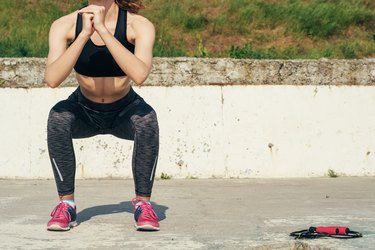
Slimming down your legs is possible as long as you understand the basics of fat loss. You cannot force your body to lose fat from a particular area. Instead, you have to focus on getting leaner overall through diet and exercise.
Slimming Down Your Legs
Video of the Day
Your legs are naturally bigger and stronger than the upper body. Women, in particular, are prone to storing fat in their legs and gluteal region, according to a July 2018 review published in Current Diabetes Reports.
Video of the Day
Tip
Aerobic exercise like jogging, or high-intensity interval training, such as sprints, can help you burn fat from your legs. Resistance training makes it easier to build and maintain muscle.
As the researchers note, women tend to store fat in the lower body. Men, on the other hand, typically have more fat around their organs in the abdominal area. This kind of adipose tissue is called visceral fat and has negative effects on cardiometabolic health.
Therefore, women are generally healthier and less likely to have heart problems. Unfortunately, you can't choose where your body stores fat. You can, however, change how much fat is stored.
To slim down your legs, you can either lose muscle, torch fat or both. It depends on what kind of look you're going for. Reducing fat but keeping muscle will give your legs a more toned look. A decrease in fat and muscle mass will make your legs smaller overall.
Dieting for Negative Energy Balance
Whatever you decide, you will have to cut your calories and start or improve your daily workout routine. The key to losing fat is getting into a negative energy balance. According to the National Heart, Lung and Blood Institute, it's necessary to burn more calories than you consume to get into a negative energy balance.
Your energy balance on a given day won't make a difference. Start to think about your energy balance over time. The key is to create a caloric deficit over several weeks or months, depending on your goals.
Read more: 11 Slimming Secrets From Leading Nutritionists
To determine your energy intake for fat loss, you may use an app that will show you how many calories you need based on your height, weight, age, gender and activity level. After you figure out roughly how many calories you should aim for, set a target to eat slightly under that number.
Dieting helps tip the scales when it comes to energy balance, but exercise is extremely important. When you're in a negative energy balance and losing fat, you're also at a greater risk of losing muscle. If you want your legs to have a muscular, toned look, it's important to keep as much muscle as possible.
Cardio or Weight Training?
A January 2018 study published in the International Journal of Sports Nutrition and Exercise Metabolism suggests that resistance training helps preserve and even increase muscle mass during dieting. Researchers who conducted this small, 40-person study have found that total-body resistance training, in addition to high protein intakes, was more effective than diet alone for preserving muscle mass in postmenopausal women.
There are two main categories of workouts: resistance and aerobic training. Whether you lift weights or run on the treadmill, you're torching calories. Aerobic training works well for burning fat and lowering overall body mass, according to a small study published in the Rehabilitation Journal in June 2018.
If cardio isn't your thing, you can opt for weight training to slim down your legs and improve body composition. In a January 2018 study featured in the Journal of Sports Medicine and Physical Fitness, middle-aged women who lifted weights burned fat and built muscle.
Read more: How to Slim a Pear-Shaped Body
Crank Up the Intensity
If you're pressed for time or get bored doing the same activity over and over, you can try high-intensity interval training. This form of exercise involves short, intense bursts of activity, such as sprinting or circuit training, followed by rest periods.
An April 2017 research paper published in Obesity Reviews has found that subjects who did HIIT not only reduced their body fat levels but also dedicated 40 percent less time to training than those engaged in moderate-intensity exercise.
However, that doesn't mean that you should discard resistance training. If you want to build muscles in your legs, you should do weighted exercises like squats, leg presses and deadlifts. An October 2018 review featured in Sports Medicine showed that aerobic exercise, such as running, doesn't build as much muscle as weight training.
You can combine aerobic and resistance training to slim down your legs while maintaining or even building muscle. Doing each type of workout two or three times per week will help you get the best of both worlds.
- Sports Medicine: "Does Aerobic Training Promote the Same Skeletal Muscle Hypertrophy as Resistance Training? A Systematic Review and Meta-Analysis"
- Obesity Reviews: "The Effects of High‐Intensity Interval Training vs. Moderate‐Intensity Continuous Training on Body Composition in Overweight and Obese Adults: A Systematic Review and Meta‐Analysis"
- The Rehabilitation Journal: "Effects of Endurance and Resistance Training on Body Composition"
- International Journal of Sports Nutrition and Exercise Metabolism: "Resistance Training Combined With Diet Decreases Body Fat While Preserving Lean Mass Independent of Resting Metabolic Rate: A Randomized Trial."
- National Heart, Lung and Blood Institute: "Balance Food and Activity"
- Current Diabetes Reports: "Gender and Sex Differences in Adipose Tissue"
- The Journal of Sports Medicine and Physical Fitness: "Strength Training and Body Composition in Middle-Age Women."